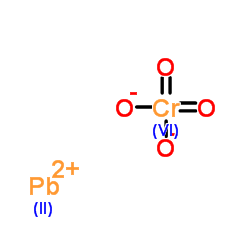Lead(2+) dioxido(dioxo)chromium

Lead(2+) dioxido(dioxo)chromium structure
|
Common Name | Lead(2+) dioxido(dioxo)chromium | ||
|---|---|---|---|---|
| CAS Number | 7758-97-6 | Molecular Weight | 323.19400 | |
| Density | 6,3 g/cm3 | Boiling Point | N/A | |
| Molecular Formula | CrO4Pb | Melting Point | 844°C | |
| MSDS | Chinese USA | Flash Point | N/A | |
| Symbol |


GHS08, GHS09 |
Signal Word | Danger | |
|
Comparison of two particulate hexavalent chromium compounds: Barium chromate is more genotoxic than lead chromate in human lung cells.
Environ. Mol. Mutagen. 44(2) , 156-62, (2004) Particulate hexavalent chromium [Cr(VI)] compounds are well-established human lung carcinogens. However, their carcinogenic mechanisms are poorly understood as most investigators have used soluble Cr(VI) compounds. Recent work from our laboratory has found th... |
|
|
Particulate and soluble hexavalent chromium are cytotoxic and genotoxic to human lung epithelial cells.
Mutat. Res. 610(1-2) , 2-7, (2006) Particulate hexavalent chromium (Cr(VI)) is a well-established human lung carcinogen. It is currently a major public health concern, there is widespread exposure to it in occupational settings and to the general public. However, despite the potential widespre... |
|
|
Homologous recombination repair protects against particulate chromate-induced chromosome instability in Chinese hamster cells.
Mutat. Res. 625(1-2) , 145-54, (2007) Particulate hexavalent chromium [Cr(VI)] compounds are well-established human carcinogens. Cr(VI)-induced tumors are characterized by chromosomal instability (CIN); however, the mechanisms of this effect are unknown. We investigated the hypothesis that homolo... |
|
|
Cytotoxicity and genotoxicity of hexavalent chromium in human and North Atlantic right whale (Eubalaena glacialis) lung cells
Comp. Biochem. Physiol. C. Toxicol. Pharmacol. 150(4) , 487-94, (2009) Humans and cetaceans are exposed to a wide range of contaminants. In this study, we compared the cytotoxic and genotoxic effects of a metal pollutant, hexavalent chromium [Cr(VI)], which has been shown to cause damage in lung cells from both humans and North ... |
|
|
Wavelength and pulse duration effects on laser induced changes on raw pigments used in paintings.
Spectrochim. Acta. A. Mol. Biomol. Spectrosc. 102 , 7-14, (2013) In this study, the reaction of widely used artist's pigments in raw form to pulsed laser radiation of different wavelengths and pulse duration was investigated. Vermilion, lead chromate and malachite (in the form of pellets) were irradiated using laser pulses... |
|
|
The clastogenic effects of chronic exposure to particulate and soluble Cr(VI) in human lung cells.
Mutat. Res. 610(1-2) , 8-13, (2006) Hexavalent chromium (Cr(VI)) is a well-designated human lung carcinogen, with solubility playing an important role in its carcinogenic potential. Although it is known that particulate or water-insoluble Cr(VI) compounds are more potent than the soluble specie... |
|
|
Ku80 deficiency does not affect particulate chromate-induced chromosome damage and cytotoxicity in Chinese hamster ovary cells.
Toxicol. Sci. 97(2) , 348-54, (2007) Particulate hexavalent chromium ((Cr(VI)) compounds are human lung carcinogens. These compounds induce DNA damage, chromosome aberrations, and concentration-dependent cell death in human and Chinese hamster ovary (CHO) cells. The relationship between Cr(VI)-i... |
|
|
XRCC1 protects against particulate chromate-induced chromosome damage and cytotoxicity in Chinese hamster ovary cells.
Toxicol. Sci. 92(2) , 409-15, (2006) Water-insoluble hexavalent chromium compounds are well-established human lung carcinogens. Lead chromate, a model insoluble Cr(VI) compound, induces DNA damage, chromosome aberrations, and dose-dependent cell death in human and Chinese hamster ovary (CHO) cel... |
|
|
Role of the Fancg gene in protecting cells from particulate chromate-induced chromosome instability.
Mutat. Res. 626(1-2) , 120-7, (2007) Particulate hexavalent chromium (Cr(VI)) is a known human lung carcinogen. Cr(VI)-induced tumors exhibit chromosome instability (CIN), but the mechanisms underlying these effects are unknown. We investigated a possible role for the Fanconi anemia (FA) pathway... |
|
|
PbCrO4 mediates cellular responses via reactive oxygen species.
Mol. Cell Biochem. 255(1-2) , 171-9, (2004) Exposure to certain particulate hexavalent chromium [Cr(VI)] compounds, such as lead chromate (PbCrO4), has been associated with lung cancer and respiratory tract toxicity. Previous studies indicate that the solubility of Cr(VI)-compounds is an important fact... |